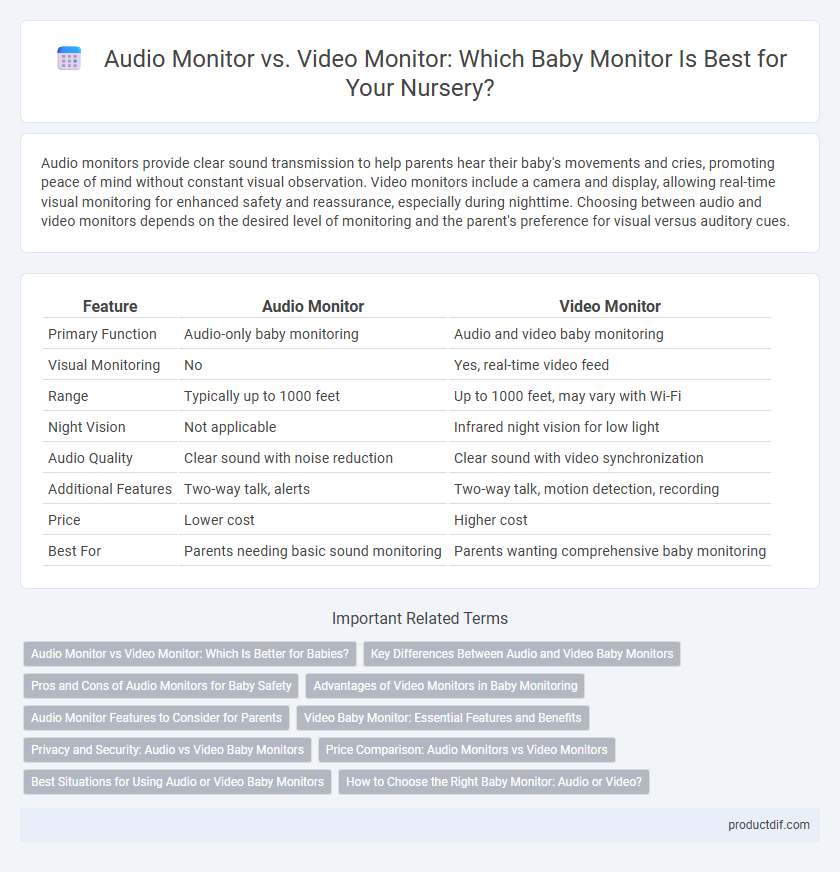Audio monitors provide clear sound transmission to help parents hear their baby's movements and cries, promoting peace of mind without constant visual observation. Video monitors include a camera and display, allowing real-time visual monitoring for enhanced safety and reassurance, especially during nighttime. Choosing between audio and video monitors depends on the desired level of monitoring and the parent's preference for visual versus auditory cues.
Table of Comparison
| Feature | Audio Monitor | Video Monitor |
|---|---|---|
| Primary Function | Audio-only baby monitoring | Audio and video baby monitoring |
| Visual Monitoring | No | Yes, real-time video feed |
| Range | Typically up to 1000 feet | Up to 1000 feet, may vary with Wi-Fi |
| Night Vision | Not applicable | Infrared night vision for low light |
| Audio Quality | Clear sound with noise reduction | Clear sound with video synchronization |
| Additional Features | Two-way talk, alerts | Two-way talk, motion detection, recording |
| Price | Lower cost | Higher cost |
| Best For | Parents needing basic sound monitoring | Parents wanting comprehensive baby monitoring |
Audio Monitor vs Video Monitor: Which Is Better for Babies?
Audio monitors provide clear sound detection to alert parents of their baby's needs, offering a cost-effective and less intrusive option. Video monitors enhance safety by allowing real-time visual monitoring, helping parents track movement and behavior for better peace of mind. Choosing between audio and video monitors depends on the desired level of supervision, budget, and specific safety preferences for the baby.
Key Differences Between Audio and Video Baby Monitors
Audio baby monitors transmit sound only, offering basic noise detection and allowing parents to hear their baby's cries from another room. Video baby monitors provide both audio and real-time video footage, enabling parents to visually monitor their baby's movements and environment through a screen or smartphone app. Key differences include the level of surveillance, with video monitors offering enhanced safety features like motion detection and night vision, while audio monitors tend to be more affordable and have longer battery life.
Pros and Cons of Audio Monitors for Baby Safety
Audio monitors for baby safety offer clear sound quality that allows parents to hear their baby's cries and movements from a distance, helping detect distress quickly. They are generally more affordable and have longer battery life compared to video monitors, making them practical for extended use. However, audio monitors lack visual confirmation, which can limit parents' ability to assess the baby's environment and physical condition in real-time.
Advantages of Video Monitors in Baby Monitoring
Video monitors provide real-time visual access to a baby's environment, allowing parents to observe their child's movements and facial expressions, enhancing reassurance beyond audio alone. They offer features such as night vision, two-way communication, and temperature monitoring, ensuring comprehensive safety and comfort. The ability to visually verify a baby's status reduces unnecessary disturbances, promoting better sleep for both baby and parents.
Audio Monitor Features to Consider for Parents
Audio monitors for babies offer essential features such as clear sound quality, long-range connectivity, and reliable interference-free channels, which provide parents peace of mind while monitoring their child from a distance. Key aspects to consider include battery life, sensitivity controls for adjusting audio levels, and two-way communication capabilities for comforting the baby remotely. Ease of use, portability, and compatibility with smart devices also enhance the overall monitoring experience for busy parents.
Video Baby Monitor: Essential Features and Benefits
Video baby monitors provide real-time visual and audio monitoring, enhancing parental peace of mind by allowing parents to see and hear their baby simultaneously. Essential features include high-resolution night vision, two-way audio communication, and secure wireless connectivity to ensure clear, uninterrupted monitoring. These benefits support early detection of distress signals and promote safer, more attentive childcare.
Privacy and Security: Audio vs Video Baby Monitors
Audio baby monitors offer enhanced privacy by transmitting only sound, reducing the risk of unauthorized video surveillance and data breaches. Video baby monitors, while providing visual reassurance, may be more vulnerable to hacking if not secured with strong encryption and secure networks. Prioritizing devices with end-to-end encryption and user authentication significantly enhances both audio and video monitor security for protecting family privacy.
Price Comparison: Audio Monitors vs Video Monitors
Audio monitors generally cost between $20 and $100, making them a more budget-friendly option for basic baby monitoring needs. Video monitors range from $50 to over $300, reflecting their advanced features such as live video streaming, night vision, and two-way communication. The price difference is significant due to the inclusion of built-in cameras and enhanced technology in video monitors.
Best Situations for Using Audio or Video Baby Monitors
Audio baby monitors are ideal for parents seeking simple, reliable sound detection in low-light or separate rooms, offering extended battery life and minimal interference. Video monitors excel in situations requiring visual confirmation, such as monitoring newborns with health concerns or ensuring safety during naps and nighttime activities. Combining audio and video features provides comprehensive monitoring in busy households or when multitasking across multiple rooms.
How to Choose the Right Baby Monitor: Audio or Video?
Choosing the right baby monitor depends on your specific needs for safety and convenience in childcare. Audio monitors provide clear, uninterrupted sound, ideal for parents who prioritize hearing their baby's cries without the distraction of a screen, while video monitors offer real-time visual updates, allowing for constant supervision and peace of mind by viewing the baby's environment. Key considerations include room layout, budget, Wi-Fi reliability for video streaming, and preference for remote monitoring versus simple audio alerts.
Audio Monitor vs Video Monitor Infographic

 productdif.com
productdif.com